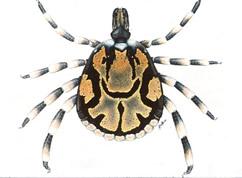- Home
- About
- Educational Resources
- Audiovisual/Teaching materials
- Livestock health, management and production
- Wildlife health, management and production
- Companion animal health
- Health management tools
- Drivers of emerging and re-emerging diseases
- Arthropod vectors
- Zoonoses
- Ecosystems and ecology
- Veterinary public health and food safety
- International trade and marketing of animal commodities and products
- Animal welfare
- Policy, planning and legislation
- CPD
- Academic programmes
- Research
- News and Events
- Links
- Contact
Vector-borne diseases

Drawing of Amblyomma hebraeum male (By courtesy of JB Walker, OVI, Onderstepoort)
Introduction
Vector-borne diseases depend mainly or entirely upon an arthropod vector for transmission of the pathogen, which may be a virus, a bacterium, or a protozoan or helminth parasite. Common disease vectors include ticks, biting flies, mosquitoes and midges. For the overwhelming majority of such diseases the vector is a biological host of the pathogen, i.e. the pathogen replicates in the vector, which may even be essential for the completion of its life cycle in the case of protozoa. However, transmission of lumpy skin disease (LSD) by arthropods is, as far as is known, mechanical, but because direct transmission between cattle is inefficient, LSD is classified as a vector-borne disease. African swine fever (ASF) is strictly vector-borne in its sylvatic cycle between warthogs and argasid ticks that live in the burrows, but once a domestic pig is infected by an argasid tick, the disease manifests as highly contagious and vectors play only a minor role if any in further spread and ASF is therefore classified as contagious rather than vector-borne. Some diseases that are only transmitted by vectors to their target hosts may be directly transmitted to secondary hosts. For example, African horse sickness (AHS) and bluetongue (BT) may infect carnivores that feed on the carcasses of animals that have died of those diseases, and humans are usually infected with Rift Valley fever (RVF) virus through contact with bodily fluids of infected animals.



